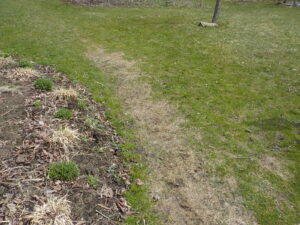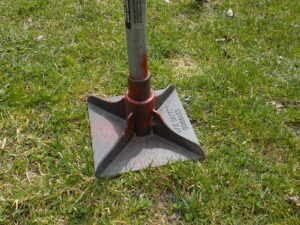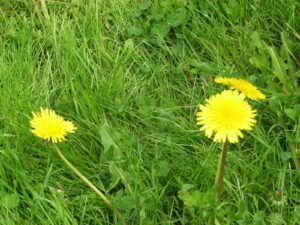Spring Lawn Care
Posted on Friday, April 29, 2022 · Leave a Comment
It’s about the right time to do a little work on your lawn if it needs it. According to Paul Sachs, the owner of North Country Organics and the author of several books on lawn care, if you want to fill in bare spots, wait until the lawn greens up after winter. And then have at it.

This dead spot was caused by too many footsteps when wet
To fix bare spots I use a short-tined garden rake to scuff up the soil. Then I scatter some seed with my hand, just sprinkling it over the spot. Next I sprinkle a thin layer of compost or fine garden soil over the seed. Not too much: most grasses need sunshine on the seed to germinate. Bury it with an inch of soil, and it won’t do well. Finally, pat it down with your foot, lightly, or with a metal tamper.
It’s important that the seed not dry out while it is getting ready to grow, so often people shade the seed with a fine layer of hay or straw. Of course hay has seeds, so straw is better, albeit more expensive. You can leave the straw and just let the seed grow through it. Later, when you mow the lawn, it will disappear.
Why do places in your lawn need help? Most lawn grasses do not like to grow in compacted soil. So if you park cars on the lawn, or walk over it every day on your way to the mailbox, it will get compacted. Enter (drum roll) CRAB GRASS. Crab grass will grow in compacted soil, but it is an annual so it dies each winter – or by late summer if gets too dry. The solution is simple: build a stone path to the mailbox and park cars only in designated parking areas.

This tamper is useful for lightly packing down seeded areas
Let’s re-think the concept of a lawn. Why do we need a large patch of short grass at an even height all around our house? Sure, people with kids and dogs need some place to play ball or Frisbee. And if you like to have friends over and sit around a barbecue grill, a little lawn is nice. But do you really like mowing an acre of lawn once a week, or paying someone else to do it? Maybe it’s time to reduce the size of your lawn and plant some more native trees and shrubs.
Entomologist Doug Tallamy is the author of a terrific book called Nature’s Best Hope: A New Approach to Conservation That Starts in Your Yard. Dr. Tallamy suggests that we can help birds and pollinators by growing native trees and shrubs – and by adding more to replace some lawn, especially in new subdivisions and in-town lots.
Birds depend on the caterpillars of moths and butterflies to feed their young. He determined that 6,000 to 9,000 caterpillars are needed to feed a clutch of chickadees from hatching to fledgling. That’s an amazing number of caterpillars, especially since most of us never even notice them.
Those butterflies and moths will mostly only lay their eggs on trees and shrubs they know: our natives. Even if your barberry or burning bush has been growing in your yard for 50 years, they probably will ignore it and look for an oak, a cherry or a willow – trees they evolved with them over tens of thousands of years.
Dr. Tallamy makes a great suggestion about how to think about lawns: think of lawn as you might throw rugs, not wall-to-wall carpeting. Bump out with trees planted along the edges of your property line, reducing the lawn with native trees. Create nice curves, then add some understory shrubs along the edge of the newly “forested” area.

‘Fireworks’ goldenrod is commonly sold in nurseries now
In addition to the oaks, native cherry and willow trees, other “keystone” trees include birches, poplars (he calls them cottonwoods) and elm. He said just 5% of the genera of plants support 75% of the caterpillars. Great perennials include goldenrod (the absolute best), asters, and members of the sunflower family. There are many tame goldenrod species that will not take over your garden, so expand your plant palette to include “Fireworks” goldenrod and other nice varieties.
But back to lawns: my philosophy of lawns is this: If it is green and you can mow it, it’s a lawn. It need not be free of dandelions and Creeping Charlie. Yes, dig out thistles, or anything that hurts your bare feet. But violets? Sure, why not? Anything that blooms will provide nectar or pollen for bees and other pollinators.
Clover actually helps your lawn, despite being called a weed by the companies that promote using the “Weed-n-Feed” chemicals that kill it. Clover fixes nitrogen, taking it from the air and putting it into the soil, reducing a need for lawn fertilizer.
If you want a rich, lush lawn, don’t cut it too short. The longer the grass, the more food produced to grow grass roots. The deeper the roots, the better the lawn will be at surviving drought.

Dandelions in lawn help feed pollinators early in the spring
When you add grass seed to fill in spots, I recommend a mix of seeds, not a pure Kentucky bluegrass, which is the neediest of all grasses. It needs fertilizer, and watering. A “Conservation Mix” will do better for you. And if you are planting in a shady area, get a mix made for shady places. Those sun/shade mixes are not as good for shady areas as those designed for them.
Soil pH is a measure of soil acidity. If you are serious about your lawn, buy a kit at the local feed-and-grain store or garden center to test the pH. If you have chlorinated water, buy some distilled water to use with the kit. If the soil pH is lower than 6.2, add some lime (ground limestone) to your soil to bring up the number. Lawns don’t do so well in highly acidic soil.
When I see a weed-free lawn, I know it‘s been treated with chemicals, and I won’t walk on it barefoot. You, your kids and dogs shouldn’t either.






